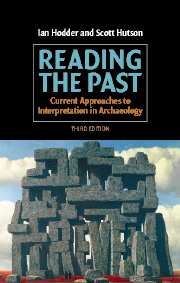Book contents
- Frontmatter
- Contents
- Preface to the first edition
- Preface to the second edition
- Preface to the third edition
- 1 The problem
- 2 Processual and systems approaches
- 3 Structuralist, post-structuralist and semiotic archaeologies
- 4 Marxism and ideology
- 5 Agency and practice
- 6 Embodied archaeology
- 7 Archaeology and history
- 8 Contextual archaeology
- 9 Post-processual archaeology
- 10 Conclusion : archaeology as archaeology
- Bibliography
- Index
10 - Conclusion : archaeology as archaeology
Published online by Cambridge University Press: 05 June 2012
- Frontmatter
- Contents
- Preface to the first edition
- Preface to the second edition
- Preface to the third edition
- 1 The problem
- 2 Processual and systems approaches
- 3 Structuralist, post-structuralist and semiotic archaeologies
- 4 Marxism and ideology
- 5 Agency and practice
- 6 Embodied archaeology
- 7 Archaeology and history
- 8 Contextual archaeology
- 9 Post-processual archaeology
- 10 Conclusion : archaeology as archaeology
- Bibliography
- Index
Summary
The archaeology for which we have been advocating attempts to capture a new openness to debate in archaeology – a broadening to include a variety of influences including Marxism, structuralism, practice theories, embodiment, feminist critiques and public archaeology. At the same time, the aim is to establish archaeology as a discipline able to contribute an independent voice to both intellectual and public debates. The contextual approach discussed in chapter 8 is one way of doing this which we personally find attractive, given our own views of the society in which we live and of what ought to happen to it, and given our opinion of the development of archaeology over the last 20 years.
In contributing to and being involved in broader interdisciplinary debate, archaeologists read various types of general meaning in their data. We have discussed three overlapping types of meaning. One is the meaning of objects as physical, involved in exchanges of matter, energy and information; the concern here is with the object as a resource, functioning after its production, to facilitate organizational needs. A second is the meaning of objects in relation to the structured contents of historical traditions. A third kind of meaning – operational meaning – resides in the specifics of the context of each event or expression. Operational meaning is shaped by the previous two meanings but also takes into account (1) the specific intentions underlying the discrete actions of people in the past and (2) the unique lived, embodied experience of each actor.
- Type
- Chapter
- Information
- Reading the PastCurrent Approaches to Interpretation in Archaeology, pp. 236 - 247Publisher: Cambridge University PressPrint publication year: 2003



